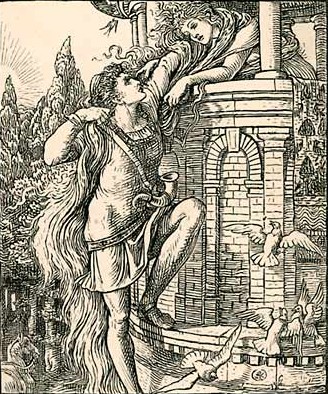But What Color Are Her Eyes?
In my fall fiction writing class, a common suggestion during critiques went something like: "I couldn't tell what kind of haircut she had...I wanted to know what color her eyes were. I just couldn't tell what she actually looked like!"
 Sometimes, another person might try to help the writer along toward a more concrete description by suggesting that the central character give us this information by catching sight of her reflection in passing mirror or window, or in the bend of shiny spoon, or the wavery pool of a lake. Whenever someone asked wanting to writer to pause to describe the protagonist, I wanted so suggest that we refer back to any of the published stories we'd read for class. Very seldom does E. Annie Proulx have a character stop and ponder the amber sheen of her own eyeballs or the flowiness of her blond hair. Raymond Carver, though he may describe the blind man in "Cathedral," doesn't pause to ponder his own bloodshot eyes in the bathroom vanity. But both writers do give us a sense of the characters through the action of story--by how they behave, by how others react to them, by how they feel about themselves in general.
Sometimes, another person might try to help the writer along toward a more concrete description by suggesting that the central character give us this information by catching sight of her reflection in passing mirror or window, or in the bend of shiny spoon, or the wavery pool of a lake. Whenever someone asked wanting to writer to pause to describe the protagonist, I wanted so suggest that we refer back to any of the published stories we'd read for class. Very seldom does E. Annie Proulx have a character stop and ponder the amber sheen of her own eyeballs or the flowiness of her blond hair. Raymond Carver, though he may describe the blind man in "Cathedral," doesn't pause to ponder his own bloodshot eyes in the bathroom vanity. But both writers do give us a sense of the characters through the action of story--by how they behave, by how others react to them, by how they feel about themselves in general. The other problem with this suggestion is that, particularly if you have a first person narrator, it's very difficult to have him describe himself without sounding awkward: "At 5'2" and 187 pounds, I realized I was a real fathead." So, I say, if it doesn't matter to the overall arc of the story if the narrator's hair is blond or brown, frizzy or in bouncy ringlets, skip it. Otherwise, you end up writing what Janet Burroway calls All-Points-Bulletin (APB) descriptions, like the one mentioned above; descriptions that give us the same generic detail a witness at a crime might mention to the cops but not much insight into the interior life of the character.
Perhaps what the workshop critic meant was that she didn't have an overall clear sense of the characters; couldn't see whether she sailed tripplingly down the sidewalk or clomped like a Matterhorn across the cement.
Unfortunately, this suggestion led to subsequent drafts where writers were trying very hard to let us know if the person had blue eyes or brown. In a book like Toni Morrison's The Bluest Eye, this detail is necessary and important to the plot. However, in a story about a girl going to the grocery store to try to pick up the last available ham for a last minute family reunion, brown or blue doesn't matter. Unless she's adopted, or perhaps a model or if a plot point in the story will feature her eyeball being poked out by an angry customer angling for the last ham.
In the latest issue of Poet's and Writers, there's an article called "Get a Job" by Benjamin Percy, where he gives this advice about how to write good physical descriptions (though the piece is primarily about another good bit of writing advice, to consider the character's job and how it impacts his life): "The trucker does not describe his laugh as a booming bassoon. The trucker laughs like a hot tire ripping apart at eight-five miles an hour. The kindergarten teacher has Crayola-blue eyes, not gunmetal blue eyes. Unless of course the title of the story is 'Mrs. Snodgrass Finally Snaps.'"
So, the next time you start writing a story, worry less about communicating the eye/hair color of your character and more about how you're going to use each sentence to create an interesting visual image of her movement through the world. I suppose it doesn't hurt to know in your mind how she looks, but unless her long hair is going to get caught in the machinery of a Ferris wheel, or her azure eyes are going to give a Jewish woman entre into the Third Reich, let those details slide and focus instead on what can be revealed about her internal life and conflict through exact descriptions.

Comments
I was writing something smallish for my own enjoyment & as a hobby, but I didn't know how to convey that my main character was grey eyed or dark haired.
Thank you!
P.S.: Wishing you a Happy New Year!